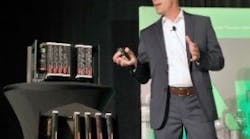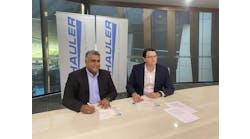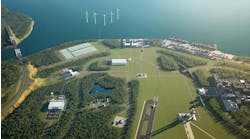“Validation took 16 hours instead of the previous 54 hours per burner, and the facility was able to start up four days earlier. Four days of runtime would buy a lot of Triconex systems.” Chris Stogner, Triconex offer director, co-presented “Triconex Technology Update” with Steve Elliott, senior director, marketing, Schneider Electric, at the 2018 Triconex User Group conference this week in Galveston, Texas.
CEOs, plant managers and marketing people say, “Safety is our #1 priority,” but do their investments match their rhetoric? “Safety is too often seen as a cost, not something that adds market value,” said Chris Stogner, Triconex offer director, Schneider Electric Process Automation. “But getting safety wrong is not an option. An incident can do permanent damage to brand equity.“So how do we get safety funded? Profitability depends on safety. A plant that’s tripping all the time is not profitable. If it’s profitable but unsafe, it may lose its license.”
Stogner co-presented “Triconex Technology Update” with Steve Elliott, senior director, marketing, Schneider Electric Process Automation, at this week’s EcoStruxure Triconex User Group conference in Galveston, Texas.
Plants are driven by imperatives from production commitments and delivering shareholder value to maintaining their license to operate, their reputation and their duty to protect people and the environment. “Now, some countries are changing the way they fine and prosecute safety violations,” Stogner said. “They will put you in jail.”
Opportunities to improve safety are available via digitalization, connectivity, big data and analytics, digital twins and the cloud, but not without risk. “Cybersecurity has gone from theoretical to actual costs,” Stogner said. “Apps and analytics are giving opportunities for better safety, but also greater cyber risks.”
Some risk is inevitable. “The best safety system would be none—an inherently safe process,” Stogner said, “But we need the products of unsafe processes, so we need safety systems. The question becomes, how do we contain the costs?”
The ghost of Triconex past
To understand where EcoStruxure Triconex systems are today and where they’re going, it helps to understand the trajectory of the past few years, said Elliott, starting in 2012, when Triconex closed the loop on safety systems. “We added the ability to measure what’s happening, compare it to the system design, identify the integrity gap, and close it.”
In 2013, Peter Martin, vice president of innovation and marketing, Schneider Electric, attributed a financial aspect to the gap and explained how to make decisions that balanced production, commercial and safety results.
In 2015, Martin and the company received a patent on software that quantifies the value of the risk reduction contributed by a safety instrumented function (SIF). Triconex also added automated testing, which has since “manifested in a standard,” Elliott said.
2016 brought IEC 61511 Edition 2, in which section 16 specifies that “the required SIL of each SIF is maintained during operation and maintenance” and “the SIS is operated and maintained in a way that sustains the required safety integrity.” Further, “Discrepancies between the expected behavior and the actual behavior of the SIS shall be analyzed and where necessary, modifications made such that the required safety is maintained.”
In 2017, along with innovation at the connected products and edge control levels, “Analytics brought a wealth of research, competence and skill,” Elliott said. “Now, safety can be profitable if you focus on the interrelationship among productivity, performance and profit.”
Triconex technology today
This year brings a significant number of innovations across the Triconex product line. Here are just the high points—each product has more:
Trip Analyzer is “a lighter version of SIF Manager, a software tool that does high-speed datalogging of what happened during a trip,” Stogner said. Today, everybody has their own way to analyze a trip, gathering information from disparate sources such as the safety system, DCS and historian. “Now, you can get a report that tells exactly what happened, with actual vs. design intervals.” If the system works as designed, “You can get a credit for a proof test.”
Trip Analyzer also offers pre- and post-event trends. “Anything that can get into the historian can be tracked,” Stogner said. “Some of the early adopters are saying it takes them one-third less time to analyze and restart. That’s a much faster return to profitability.”
SIF Manager supports the IEC 61511 part 16 clauses with automatic analysis and reporting of SIF demand rate performance, bypass performance, trip performance statistics, device failure statistics, live statistics, proof test tracking, fault tracking, dynamic PFD calculation and more.
Implementing SIF Manager at a 540,000 BBL/day, $25M revenue per day refinery with 2,000 SIFs and 10,000 SIS devices, on a three-year plant turnaround cycle with two safety audits per year, a five-year SIF validation cycle and four to seven 4-7 trips per year (average) calculates to an ROI of six months based on labor savings, or two days based on reduced turnaround time.
Among 2018’s “apps and analytics,” Stogner said, Safety View ABM 2.0 “eliminates the chance that a critical alarm will go unnoticed.” It keeps bypasses “done properly and visible, not in the DCS or out on the floor.”
EcoStruxure Maintenance Advisor pulls in data from HART-enabled devices, contextualizes it, “makes it easy to see what to do, and to generate a work order,” Stogner said.
Triconex Safety Validator offers faster validation and “the only TÜV certified safety logic validation,” Stogner said. There’s no reason to write procedures from scratch because they’re generated in the software. “I can hit the ‘play’ button, go out and have lunch, come back and see how the testing went.”
At Chevron in Pascagoula, installation of six new burners “took half the time for the factory acceptance test (FAT),” Stogner said. “Validation took 16 instead of the previous 54 hours per burner, and the facility was able to start up four days earlier. Four days of runtime would buy a lot of Triconex systems,” Stogner said.
It also provides management of change. “If you make a small change, do you have to re-verify the whole system?” Stogner asked. “It’s up to you—you can do the analysis, or with this, you can just test it all, automatically.” A free trial version is available for up to 4 months.
Tofino Firewall has been updated to handle up to 254 nodes with support for extended alias, Tricon CX and HART pass-through.
Tricon 11.4 is the “first post-attack-investigation version,” Stogner said, referring to the well-publicized but ultimately unsuccessful Triton malware attack in 2017. “By the way, that was a 17-year-old system. That attack would have been prevented if the user had followed the recommendations in the user guide.” On the new version, so as to not tip off any hackers, “We’re not talking about all the ways it works.”
Safety Suite now supports Tricon CX, with TriStation V4.16 and Enhanced Diagnostic Monitor V2.13. Diagnostics have configurable limits, and HART devices can be configured from TriStation.
“Diagnostic Expert is merging a couple of applications into one,” Stogner said. “It includes TriLogger capability and an OPC UA server.”
TriStation 5.x means “If you are using more than one version, you no longer need a separate install for each version,” Stogner said. “From here out, the latest version of 5.x will open earlier 5.x versions.”
System Advisor change tracker knows “when, who, the old value and the new value,” Stogner said, “So, TriStation upgrades won’t require printouts and page-by-page comparison to highlight changes.”
Tricon CX is “released and ready for purchase,” Stogner said. Now at V11.4, it has an approved component list on “one certificate, one TÜV approval.” Containing the “ghost of Triconex past,” it has the same contents in a more cost-effective footprint—50% smaller, 67% lighter in weight, so it can be added to racks in the existing space. It’s also rated ISA Secure and RoHS, and “We’re working on marine.”
“It takes the best of Tricon,” Stogner added, uses an external power supply and handling up to 15 I/O modules per chassis. A unified communication module (UCM) puts it directly on a EcoStruxure Foxboro DCS; a new supervised 24 Vdc digital input has 1 ms sequence of events (SOE); a fast analog input offers 5 msec updates; and HART pass-through allows automated HART device configuration, documentation and test.
Safety Intelligent Enclosures can be bought by I/O count, installed in the field, then configured to the final I/O type with software and plug-ins. They can be installed in daisy-chain, star or mixed topologies. “One box has four modules, 64 points, and two guys can install it by hand,” Stogner said. “No A/C, no purge—it’s rated to 55 °C (130 °F) ambient. We did accelerated life testing, running two weeks at 4 cycles per day from -20 °C to 70 °C with no failures. That’s equivalent to 20 years at up to 55 °C.”
The editors of Control were on site at the 2018 Triconex User Group Conference to bring you breaking news, innovations and insights from the event. Now that the event is over, the editors have put together an event report featuring the top news. Get your copy today.




